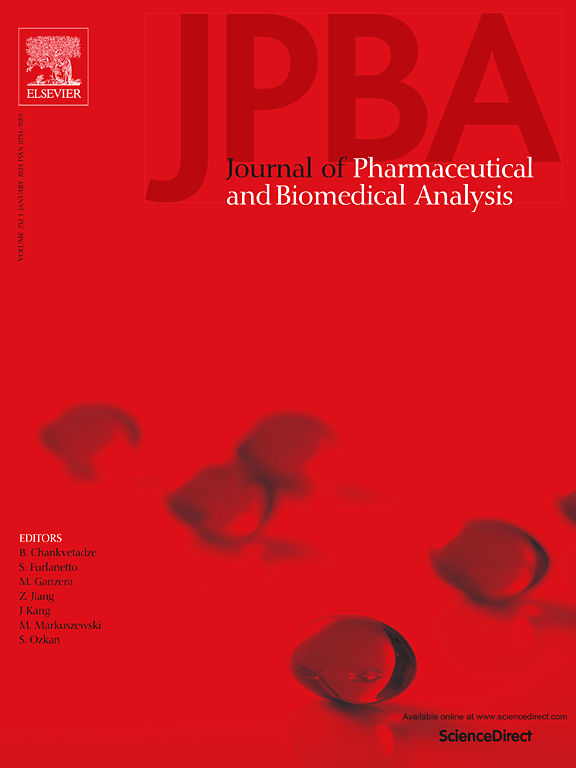基于GC-MS代谢组学和胆汁酸代谢途径,探讨石膏皂苷治疗大鼠肝损伤的机制
IF 3.1
3区 医学
Q2 CHEMISTRY, ANALYTICAL
Journal of pharmaceutical and biomedical analysis
Pub Date : 2024-10-09
DOI:10.1016/j.jpba.2024.116506
引用次数: 0
摘要
绞股蓝是葫芦科的一种草本藤本植物,其主要药理成分绞股蓝甙(GPs)已被证实对多种肝脏疾病有效。然而,GPs 对肝损伤的作用机制仍有待进一步研究。本研究利用 CCl4 诱导的肝损伤大鼠模型(LI),通过比较四组大鼠的代谢组学变化,全面探讨 GPs 治疗化学性肝损伤的作用机制。本研究通过炎症因子、氧化损伤指标和组织病理学切片评估了 GPs 在每周灌胃 CCl4 诱导的肝损伤大鼠模型中的疗效。然后,利用气相色谱-质谱(GC-MS)技术鉴定了 GPs 治疗肝损伤的代谢谱。最后,测定代谢物(BAs 和 SCFAs)的含量变化,以阐明 GPs 治疗 CCl4 引起的肝损伤的机制。给药8周后,GPs有效降低了LI的程度,并在MDA、GSH、CYP7E1、CYP7A1和CYP27A1的水平上出现了显著的逆转趋势。非靶向代谢组学表明,GPs 可能在 BAs 和 SCFAs 代谢中发挥作用。靶向代谢组学和酶联免疫吸附试验证实了 GPs 在增加 SCFAs 含量和调节 BAs 代谢中的关键作用。总之,本研究表明 GPs 可减轻 CCl4 诱导的肝损伤。GPs可能通过影响肝脏代谢产物(SCFAs和BAs)对肝损伤产生有益影响。本文章由计算机程序翻译,如有差异,请以英文原文为准。
To explore the mechanism of gypenosides in the treatment of liver injury in rats based on GC-MS metabolomics and bile acid metabolism pathway
Gynostemma pentaphyllum is a herbaceous vine of Cucurbitaceae family, and its principal pharmacological components, gypenosides (GPs), have been proved to be effective in various liver diseases. However, the mechanisms of GPs on liver injury are still to be studied for further. This investigation utilized the CCl4-induced liver injury rat model (LI) to comprehensively explore the mechanism of action of GPs in the treatment of chemical liver injury by comparing the metabolomic changes in four groups rats. In this study, the therapeutic efficacy of GPs in a liver injury rat model induced by weekly gavage of CCl4 was evaluated by inflammatory factors, oxidative damage indexes, and histopathological sections. Then, GC-MS technology was used to identify the metabolic profile of GPs in treating liver injury. Finally, the content variation of metabolites (BAs and SCFAs) was measured to elucidate the mechanism of GPs in the treatment of CCl4-induced liver injury. After 8 weeks of administration, GPs effectively reduced the degree of LI and appeared a substantial tendency of reversing in the levels of MDA, GSH, CYP7E1, CYP7A1 and CYP27A1. Untargeted metabolomics suggested that GPs may play a role in BAs and SCFAs metabolism. Targeted metabolomics and ELISA confirmed the key role of GPs in increasing SCFAs levels and regulating BAs metabolism. Overall, this study indicated that GPs can alleviate CCl4-induced liver injury. And GPs may exert beneficial effects on LI by affecting their metabolites (SCFAs and BAs).
求助全文
通过发布文献求助,成功后即可免费获取论文全文。
去求助
来源期刊
CiteScore
6.70
自引率
5.90%
发文量
588
审稿时长
37 days
期刊介绍:
This journal is an international medium directed towards the needs of academic, clinical, government and industrial analysis by publishing original research reports and critical reviews on pharmaceutical and biomedical analysis. It covers the interdisciplinary aspects of analysis in the pharmaceutical, biomedical and clinical sciences, including developments in analytical methodology, instrumentation, computation and interpretation. Submissions on novel applications focusing on drug purity and stability studies, pharmacokinetics, therapeutic monitoring, metabolic profiling; drug-related aspects of analytical biochemistry and forensic toxicology; quality assurance in the pharmaceutical industry are also welcome.
Studies from areas of well established and poorly selective methods, such as UV-VIS spectrophotometry (including derivative and multi-wavelength measurements), basic electroanalytical (potentiometric, polarographic and voltammetric) methods, fluorimetry, flow-injection analysis, etc. are accepted for publication in exceptional cases only, if a unique and substantial advantage over presently known systems is demonstrated. The same applies to the assay of simple drug formulations by any kind of methods and the determination of drugs in biological samples based merely on spiked samples. Drug purity/stability studies should contain information on the structure elucidation of the impurities/degradants.

 求助内容:
求助内容: 应助结果提醒方式:
应助结果提醒方式:


